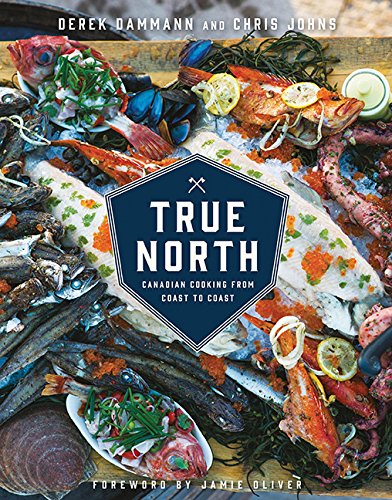
TORONTO—Revving up a snowmobile to cook beans with its muffler was just one adventure had by chef Derek Dammann and writer Chris Johns while researching their stunning new book, “True North.”
But after a few hours touring a rural Quebec bush on a glorious -25 C day, the beans in their Muffpot cooker were still cold.
“There was a huge acreage and we went in the field, just 80 kilometres an hour, zoom, trying to get the engine hot enough to cook the beans,” recalls Dammann.
They ended up cooking them on a stove.
“I do not endorse the Muffpot. They’ve got to make some serious changes,” Dammann adds, chuckling.
In the foreword of “True North: Canadian Cooking From Coast to Coast” (HarperCollins Publishers Ltd.), British celebrity chef Jamie Oliver writes a laugh-out-loud introduction to his friend of more than a decade.
The two chefs first met when Dammann lunched at Oliver’s Fifteen restaurant in London, the day before he was due to fly back to Canada at the end of a trip to study European food. Despite “alarm bells ringing” that Dammann was “showing all the signs of an obsessive stalker,” Oliver writes he agreed to Dammann’s proposal to don an apron for a stint in the kitchen that night.
At midnight, when an impressed Oliver said he would have given him a job as a senior chef if he wasn’t leaving the country, Dammann shouted, “I’ll take it,” cancelled his flight and worked at Fifteen for three years.
“Damn, that boy can cook,” Oliver writes. “I really think he’s up there with some of the absolute best chefs in the world.”
Dammann chortles about Oliver’s foreword during an interview at the publisher’s Toronto office.
“I was ready to dance with it, just whatever it was, accept it, but then it’s even funnier,” says Dammann. “He calls me a virgin and a psycho. It’s funny.”
Oliver later invested in Dammann’s 50-seat Montreal restaurant Maison Publique, which opened just over three years ago and is quintessentially Canadian.
“There’s a few artistic liberties, like there’s olive oil and lemons and stuff like that. But 90 per cent of the menu is Quebec in the seasons,” says Dammann, whose former Restaurant DNA featured nose-to-tail eating.
“True North,” which alludes to the national anthem in its title, celebrates Canadian food through the experiences of Dammann and Johns, who spent 3 1/2 years gathering material for the book.
“There’s a stereotype to Canadian food for sure, just like BeaverTails and back bacon and the poutine and … doughnuts. Everyone’s seen (the film) ‘A Strange Brew’ and you get the idea of what everyone’s vision of what Canadian cuisine is,” says Dammann, who grew up in Campbell River, B.C.
“But we just wanted to show through our eyes—with the ingredients and the travel and the stories—the way we look at it.”
The chapters are arranged by ingredients from the locations that inspired them—Atlantic, Forest, Field, Farm, Orchard and Vineyard, and Pacific—and illustrated with gorgeous food and landscape photos.
The duo elected to start their odyssey at the Roots, Rants and Roars Festival in remote Elliston, N.L., which Johns calls the root cellar capital of the world.
While in the province, they hauled in cod in the drizzle outside Quidi Vidi Gut, had a traditional Jiggs dinner in a church gymnasium, and marvelled at the resources available to area chefs, from shellfish to moose to ptarmigan.
On the West Coast, they gained an appreciation for the dedication of fishermen while hunting for spot prawns. The crustaceans were previously mostly exported but have become prized among seafood fanciers.
Dammann, who’s used to long days on his feet as a chef, found three days on the boat exhausting.
“One thing about all the people we met with—fishermen or winemakers or farmers or other chefs—is just they all share that in common, just this incredible amount of work, and hard work, that they do,” says Johns.
The Toronto-based freelance food and travel writer found the Prairies fascinating.
“These days people are kind of focused on this idea of obscure foraged vegetables from the side of the ocean, or those are kind of the ‘cool’ things. But really what’s going on in the Prairies with the lentils and the pulses and mustard and canola, we’re feeding the whole world with this stuff,” says Johns.
“Those ingredients are often overlooked because they’re so ubiquitous. But they’re incredibly and hugely important to defining what is Canadian cuisine.”